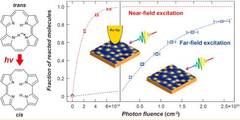Near-field enhanced photochemistry of single molecules in a scanning tunneling microscope junction
| Reviews and Highlights | Quantum Science | Molecular and Soft-matter | Ultrafast Nano-optics and Nanophotonics | Mineralogy and Geochemistry |
|---|
Hannes Bockmann, Sylwester Gawinkowski, Jacek Waluk, Markus B. Raschke, Martin Wolf, and Takashi Kumagai
Nano Lett. 18, 152 (2018).
DOI PDF SI

Optical near-field excitation of metallic nanostructures can be used to enhance photochemical reactions. The enhancement under visible light illumination is of particular interest because it can facilitate the use of sunlight to promote photocatalytic chemical and energy conversion. However, few studies have yet addressed optical near-field induced chemistry, in particular at the single-molecule level. In this Letter, we report the near-field enhanced tautomerization of porphycene on a Cu(111) surface in a scanning tunneling microscope (STM) junction. The light-induced tautomerization is mediated by photogenerated carriers in the Cu substrate. It is revealed that the reaction cross section is significantly enhanced in the presence of a Au tip compared to the far-field induced process. The strong enhancement occurs in the red and near-infrared spectral range for Au tips, whereas a W tip shows a much weaker enhancement, suggesting that excitation of the localized plasmon resonance contributes to the process. Additionally, using the precise tip–surface distance control of the STM, the near-field enhanced tautomerization is examined in and out of the tunneling regime. Our results suggest that the enhancement is attributed to the increased carrier generation rate via decay of the excited near-field in the STM junction. Additionally, optically excited tunneling electrons also contribute to the process in the tunneling regime.
